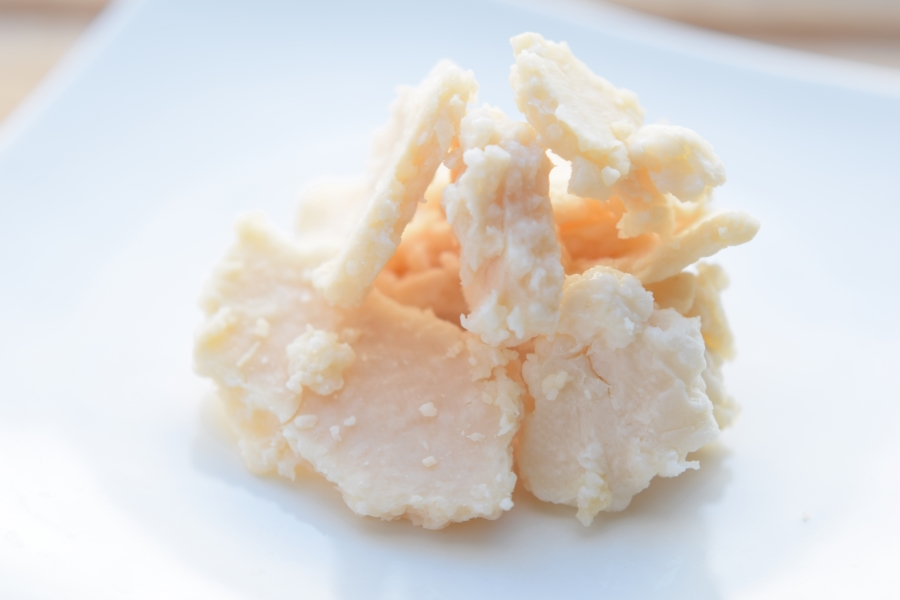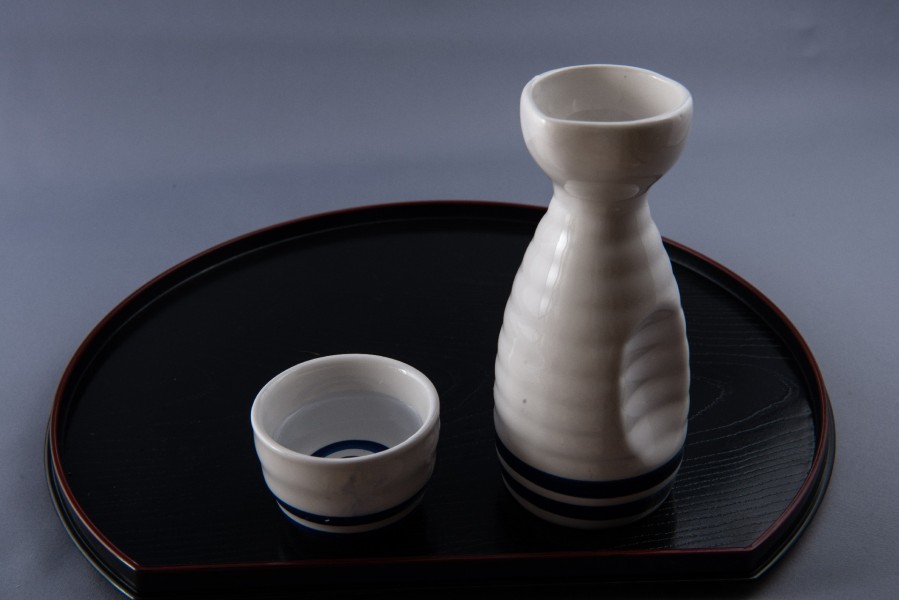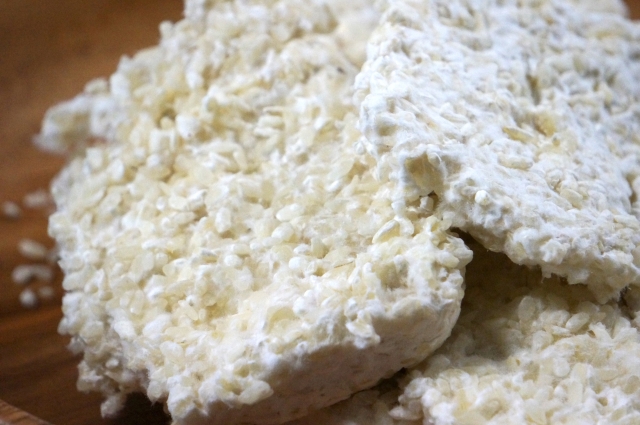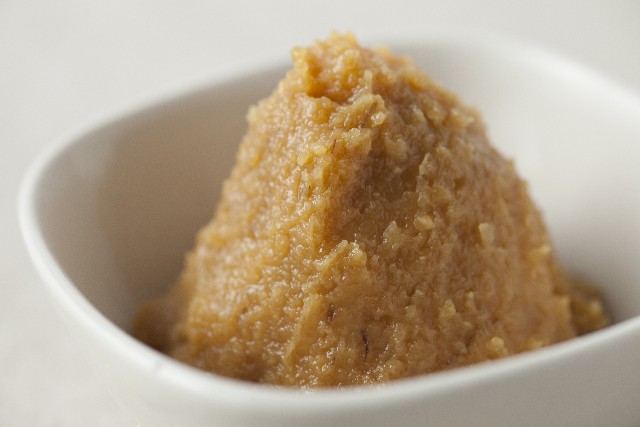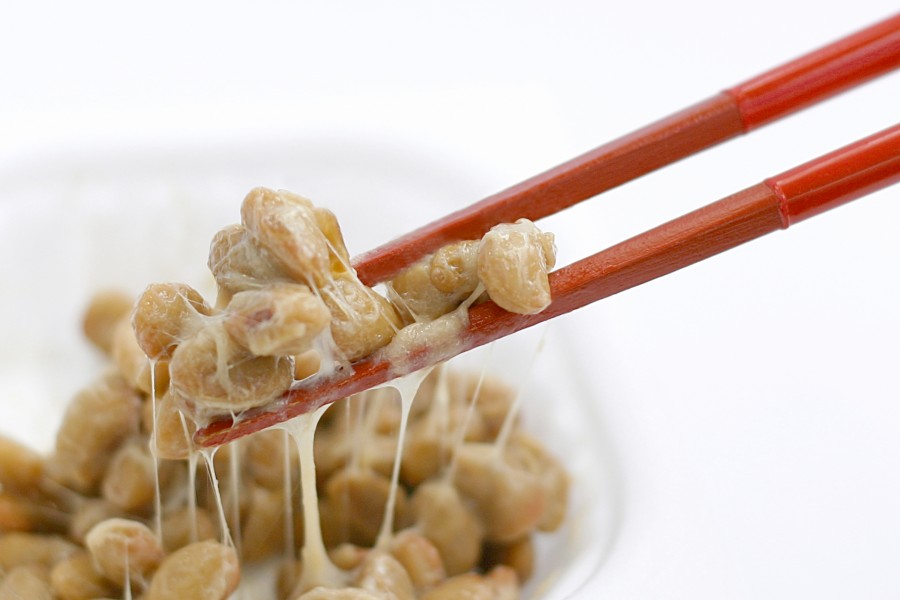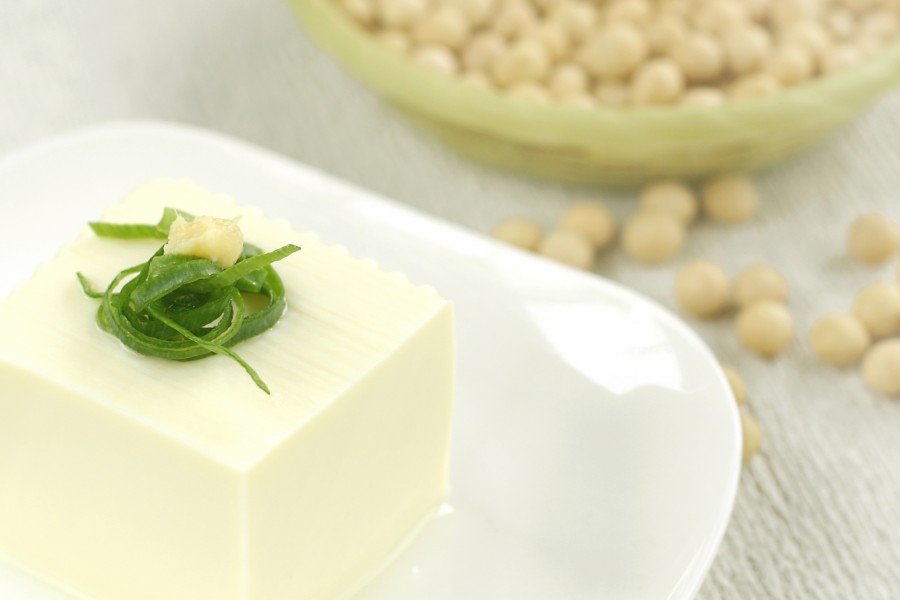Mirin kasu is born from the brewing process of mirin (sweet sake) and is made of sweet rice, malted rice, and shochu. The sweet rice gives it stickiness and a granulated drop shape. The flavor of mirin kasu is faintly sweet, as distinguished from the stronger taste of sake kasu. Contents: What is Mirin Kasu? Mirin Kasu Pickled Vegetables Recipe Mirin Kasu Pound Cake Recipe Baked Cod with Mirin Kasuzuke Recipe Soymilk Banana Shake with Mirin Kasu Recipe Crispy Mirin Kasu Cookie Recipe What is Mirin Kasu? History of Mirin Kasu As described in the book “Wakan Sansai Zue” (Chinese and Japanese All things Encyclopedia) from the rnid-Edo Period, mirin kasu has been consumed since long ago as a “sweet […]
Have you noticed a mysterious looking brown item lined up in the pickle section? It looks really strange, and for those of you who have never tried it, its appearance hardly invites you to reach for it. This is a form of pickle called “Narazuke.” Contents: What is Narazuke? Narazuke Recipe What is Narazuke? Narazuke refers to vegetables of the gourd family that are pickled in sake lees. It is said to have originated in the Kansai region of Japan. At one time, it was apparently a very expensive food that only those in the upper class could enjoy. Later, in the Edo period (1603-1868), it came to be widely consumed by the general public. It is said that the […]
Sakekasu is made from steamed rice and kome-koji (rice malt). During the fermentation process that produces sake, the solids, or lees, that remain after the liquid is captured is called sakekasu. Contents: What is Sakekasu? Sakekasu Recipe What is Sakekasu? Sakekasu has health as well as cosmetic applications. It contains protein, carbohydrates, dietary fiber, vitamins, organic acids, and minerals. It also provides folic acid and amino acid peptides, Aspergillus, and yeast-derived β-glucan. Sakekasu may also prevent osteoporosis and constipation and may lower bad cholesterol levels. Since it is said to fight against modern disease, sakekasu is a food that we want to eat routinely. It also has benefits as a skin moisturizer and is widely used as a raw material […]
Makurazaki City, in Kagoshima Prefecture, is known as Japan’s top producer of katsuobushi (smoked, dried bonito). Our Wafu Dashi stock is made with an abundance of katsuobushi, produced in Makurazaki without the use of chemical seasonings (including MSG), artificial colors, etc. Thus it boasts more savory character (umami), flavor and mellow sweetness that come from quality fish and natural ingredients. In this article we’ll talk about this additive-free Nijiya Wafu Dashi stock. Contents: “Arakibushi” – Makurazaki Brand Katsuobushi Blending Shiitake Mushroom and Konbu Dashi Stock Granular-type Dashi Stock. That’s Easy to Use Dashi Stock Recipes Pork and Onion Stir-Fry with Ginger Recipe Dashi Simmered Nira and Enoki Mashroom Recipe Daikon with Ground Chicken Recipe Lightly Simmered Asari (clams) and Asparagus […]
Contents: What is Kasuzuke? Selecting Additive-Free, Wild-Caught Fish The Right Way to Make Delicious Kasuzuke Kasuzuke and Health Nijiya’s Seacret Kasuzuke Recipe What is Kasuzuke? The method of using such wild yeast as malted rice to treat fresh seafood may be unique to Japanese cuisine. Among all fish dishes, the exquisite kasuzuke is an indispensable dish in Japanese meals. Kasuzuke adds a distinctive flavor to fish while removing its fishy odor. The rare, sophisticated taste and excellent nutritional value of kasuzuke are now attracting food lovers throughout the world. In Japan, the harvest season for new rice crops is the time when the brewing of new sake begins. When the sake brewing is nearly complete, fresh sake kasu (sake lees) […]
Himono refers to a method of food preservation that has existed since the Jomon Period (14,000-300 BC). This method is excellent and convenient as it allows many types of fish to be preserved for consumptions all year round. Himono values the process of “drying” where the umami of the fish is extracted by exposure to the sun’s rays. Contents: The History of Himono Nutrients of Himono Himono Recipes Himono Ratatouille Recipe Himono-no-Sunomono Recipe Himono Mixed with Grated Daikon Recipe Chirashi Sushi with Himono Recipe Fried Dried Fish Recipe The History of Himono Sakana-no-himono is now widely available in the supermarket. The method of preserving fish as himono has apparently been practiced since the Jomon Period (14,000-300 BC): fossils of dried […]
Contents: What is Gindara? Gindara Recipes Gindara Kasuzuke Recipe Simmered Gindara Nitsuke Recipe Gindara Agedashi (deep-fried gindara) Recipe Yu-an Style Grilled Gindara Recipe Easy Foil-baked Gindara Recipe What is Gindara? Gindara is a relatively expensive fish in Japan. It is known for its soft-textured flesh with high fat content, and it’s an excellent fish for simmering or baking. The best ways to eat gindara are probably kasu-zuke and saikyo-zuke. Cooking gindara by these methods will remove the excess water from the fish and trap the fat content within the fish. Gindara becomes even more flavorful when cooked together with the flavors of sake lees or Saikyo miso. In Japan there are stores that specialize in kasuzuke, and each year trips […]
Contents: Miso Comes in a Variety of Shapes and Forms Moromi-Miso Recipe Miso Comes in a Variety of Shapes and Forms Miso is normally used in soups and/or cooked dishes. However, some types of miso are used alone as a topping for plain-tasting foods, eaten as a snack with drinks, or put on steamed rice. These types of miso are referred to as “okazu miso.” Kinzanji-miso is a wellknown example of okazu miso. Moromi-miso refers to a soft, solid mass where the raw ingredients brewed to make soy-sauce or sake become fermented. Put simply, it is a stage of fermentation prior to becoming soy sauce. To make moromi-miso, the koji (malted rice) made from wheat, soybeans, rice, etc., is fermented […]
Japanese sake is a unique alcoholic beverage, and it is deeply rooted in the culture and climate of Japan. Contents Discovering Sake Sake Brewing Hot Sake & Cold Sake Seimai (Rice Polishing) Paring Sake and Food How to use Japanese Sake for cooking? Discovering Sake Its tradition and the future Japanese sake can be argued that it’s an expression of the Japanese people and their history. On the other hand, more and more people in other parts of the world are discovering sake, and its popularity is growing ever more rapidly. What makes sake so unique is that it is both a very Japanese product at its core while becoming a worldwide phenomenon? It is surely not only the flavor […]
In Japan, amazake (hot sweet sake) is sometimes served during the New Year’s visit to a shrine or the Girls’ Festival in March. Contents: Sweet Hot Drink, Amazake How to cook Amazake? Recommended Amazake Products Sweet Hot Drink, Amazake Many of Japanese remember drinking a cup of hot amazake on a cold day around a bonfire, and feeling energy welling up inside us. Surprisingly, however, amazake is a seasonal word for summer. During the Edo era there were merchants who hawked amazake as a nutritional supplement during summer to people who were prone to exhaustion or lost their appetite due to the intense heat. Amazake contains 20% or more of glucose and is a rich source of the vitamins so […]
A variety of fermented foods such as sake, soy sauce, and miso have been supporting the diets of Japanese people since ancient times. An essential ingredient in these fermented foods is the edible fungus called koji (Aspergillus oryzae). Contents What is Koji? What is Shio-Koji? How to use Koji for cooking? What is Koji? Shio-koji, made with salt, and shoyu-koji, made with soy sauce, are both handmade by Nijiya. Shio-koji is made with kome-koji (rice malt) that breeds from koji on steamed rice. We do not use any unnecessary ingredients. The result is a safe and secure all-purpose seasoning. Koji is good for beauty and health and contains the nine essential amino acids. Women may especially favor these benefits: 1: […]
What is Miso Soup? Traditionally many fermented products have been eaten in Japan, because the climate encourages the growth of microorganisms. These fermented products reflect the wisdom Japanese people accumulated over centuries of experience. In particular, the idea of fermenting soybeans, which are rich in nutrients but difficult to digest, has created natto (fermented soybeans), soy sauce and miso (fermented soybean paste). As they say, “A bowl of miso soup a day keeps the doctor away”. Miso has been a health secret of the Japanese for many years. Why don’t we review our basic diet and add miso soup to our daily menu? Tofu Miso Soup Recipe Grilled Mochi and Leafy Green Miso Soup Recipe Clam Miso Soup Recipe Tonjiru […]
Soy sauce, made from soy beans, is a liquid seasoning developed in Japan. Contents: What is Shoyu? History of Shoyu How To Choose The Right Soy Sauce How To Enhance The Flavor Of Food Using Soy Sauce What is Shoyu?
Every country in the world has a unique food that has traditionally been eaten by its people. Such foods differ according to the climate, geographical influences, and history. Apparently, each food has been faithfully passed on from generation to generation while undergoing gradual changes. These traditional dishes live on to this day and have begun to make the leap from Japan out into the world. Now, why is it that Japanese food is considered good for health and has drawn so much attention from all over the globe? The following is an explanation of Japanese seasonings, the basis of Japanese cuisine, along with an in-depth study of authentic Japanese food. Contents: “Umami” (Savoriness) Is the Basis of Japanese Food Basic […]
Let’s try Natto Recipe! Many natto lovers are found in the northern and southern parts of Japan. Although natto was traditionally unpopular in the Kansai area, where residents hated its distinctive smell, the advance in biotechnology has made it possible to culture pure strains of bacillus natto to create natto having less odor. Thanks to the less smelly versions, natto is now a popular food that’s enjoyed by Japanese throughout the country. Natto is delicious but it has a distinctive smell and stickiness. Even the simplest way to eat natto—putting over on rice and sprinkling it with condiments and soy sauce—never becomes boring. When cooking natto, select ingredients that go well with this dish. You can also find recipes that […]
Natto, one of the foods based on fermented soybeans, is made with Bacillus subtilis, a bacterium so potent that it survived the ice age. Contents The Story of Natto Characteristics of Natto Effects of Natto The Story of Natto Natto is a natural food that was reportedly eaten by the ancient Japanese as early as the Yayoi period (300 B.C. – 300 A.D.). In the Nara period (710 – 794), methods to produce fish sauce, grain-based sauce, fermented bean curd, and other food items—which later developed into tofu and natto-were brought into Japan, along with Buddhism, from China. The wisdom and ingenuity of our ancestors led to an evolution of fermentation methods, eventually producing a series of fermented soybean delicacies […]
Tofu is a food made of soy milk and adding nigari (magnesium chloride) , and its’ pressed into solid white blocks. Contents: The tale of tofu – Making delicious tofu Tofu Q&A Process of Tofu Making How to make fresh tofu? Let’s make homemade tofu! The tale of tofu – Making delicious tofu Tofu can be considered the most vital ingredient that characterizes Japanese dining. Japanese people have been eating tofu since the Nara period (710-794 CE), and until this day the fundamental method of making tofu- extracting soy milk from soy and adding nigari (magnesium chloride) to harden-is still the same. For the Japanese community living in America, it was not easy to find delicious tofu until just a […]
Gari (pickled ginger) is thinly-sliced, sweetened pickled ginger and is an indispensable garnish with sushi. Because its crispy texture and refreshing and piquant taste eliminates the smell of fish, it makes sushi consumption an enjoyable experience. When eaten between bites of sushi, it cleanses and renews the palate. Contents “Sushi shoga = ginger” may be the more familiar term in America. How to Make Homemade Gari (Japanese Pickled Ginger) How to cook Gari? “Sushi shoga = ginger” may be the more familiar term in America. Demand for gari has rapidly increased along with the sushi boom in America. It is safe to say that the appreciation of gari has already spread among others besides Japanese. It appears that the origin […]


